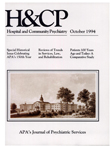An Analysis of the Two-Class System of Care in Public and Private Psychiatric Hospitals
Abstract
Our findings indicate that the public hospital had a disproportionate number of admissions with chronic mental illness and lower socioeconomic status compared with the private hospital. If the two facilities provide the same quality of care, then this finding may be less significant. However, if quality of care differs, then a judicious remedy is needed to allow less fortunate patients access to high-quality care.
The prospect of national health care reform leads to even more policy questions. Will a national health insurance package cover only chronic mental illnesses or all mental disorders? If only the most severe mental disorders are covered, who will treat those with less severe disorders? Are public and private facilities prepared to deal with potentially different populations than they are currently dealing with?
This discussion of the different populations served by public and private hospitals must be tempered by the fact that we studied only one hospital of each type using data from a short time period. To lend credence to our findings, a more in-depth study is necessary. Our research has generated several hypotheses requiring further investigation. The following suggestions would strengthen future research.
First, a quasi-experimental design, such as a multiple time series, is necessary to improve validity. This construct would include multiple measures of the variables over a longer period of time. More hospitals should be included to permit generalization of the results.
Second, including outcome measures would strengthen the study. Such measures would include patient level of functioning, compliance with aftercare and medications, employment rates, and reimbursement for services. Indicators of quality of care, such as staffing ratios, would provide useful information for identifying cost-effective methods of care that lead to good patient outcomes.
Third, a larger number of variables would permit more provocative comparisons. These variables might include length of stay, cost of hospitalization, income levels, marital status, referral sources, and so on.
Finally, a larger sample size would permit analysis by specific diagnosis instead of by general classifications. It would also allow for a potentially normal distribution, which would aid in interpreting continuous variables such as age, especially if regression analysis were used.
Although it is difficult to draw definitive conclusions from the study, the results reflect some characteristics of the two-class system of care, suggesting that those with severe and persistent illness, the indigent, and minorities disproportionately receive care in the public sector. As the U.S. health care system continues to evolve, so must the pursuit of high-quality, cost-effective inpatient care for all Americans.
Access content
To read the fulltext, please use one of the options below to sign in or purchase access.- Personal login
- Institutional Login
- Sign in via OpenAthens
- Register for access
-
Please login/register if you wish to pair your device and check access availability.
Not a subscriber?
PsychiatryOnline subscription options offer access to the DSM-5 library, books, journals, CME, and patient resources. This all-in-one virtual library provides psychiatrists and mental health professionals with key resources for diagnosis, treatment, research, and professional development.
Need more help? PsychiatryOnline Customer Service may be reached by emailing [email protected] or by calling 800-368-5777 (in the U.S.) or 703-907-7322 (outside the U.S.).



